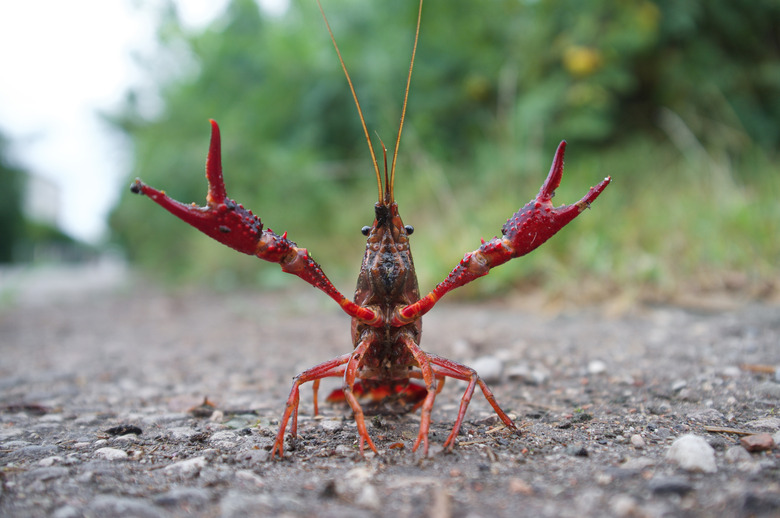How To Tell A Male Crawfish From A Female
Crawfish are small, lobster-like crustaceans that reside in fresh water around the world. Crawfish belong to the order Decopoda, which includes lobsters and crabs. Approximately 450 species of crawfish reside in North America alone. Crawfish carry numerous other nicknames, such as crayfish, crawdads and crawdaddies. These invertebrates live in streams, rivers, ponds, marshes, swamps and lakes. While males and females initially look similar, they possess important physical differences.
TL;DR (Too Long; Didn't Read)
The small crustaceans known as crawfish reside in freshwater habitats around the world. While juvenile gender may be challenging to distinguish in the field, adults can be easily sexed by looking for physical differences in their abdomens. Males also tend to be larger, with larger claws and thinner abdomens than females.
Determining Crawfish Gender
Determining Crawfish Gender
While juvenile crawfish gender is not easy to determine in the field, adults prove easier to distinguish. Males tend generally to be larger in size than females, with larger chelae and narrower abdomens. Crawfish tails host small appendages, including swimmerets. Male crawfish carry an extra set of these swimmerets, which are enlarged and hardened. Females possess a small hole just behind their swimmerets. The female's broader abdomen provides an ideal place to carry her brood.
General Crawfish Anatomy
Crawfish, being invertebrate arthropods, possess an exoskeleton made of chitin. As crawfish grow, they shed these exoskeletons during molting. Their large front legs carry disproportionately large claws called chelae. Crawfish use four pairs of walking legs to cross their aquatic substrates. The main body of a crawfish has a front part called a carapace, which is dome-shaped and made of the head and thorax. The abdomen comprises the rear of the crawfish and segments into its flattened tail. Since crawfish do not actually swim, they use their tails for rapid backward propulsion in water. Crawfish bear a pair of long antennae and two pairs of short antennae to feel their way around. Crawfish range in size from less than an inch to greater than 6 inches in length depending on species.
More About Crawfish
More About Crawfish
Crawfish reside in many types of freshwater habitats, including streams, marshes, caves, lakes and ponds. They are omnivorous and mostly nocturnal. They provide food for many other animals, including fish, foxes, raccoons, snakes, turtles, birds and of course humans. Crawfish prefer clean, natural aquatic settings along the margins of bodies of water. Bank burrows, gravel, vegetation and tree roots give natural cover, but some larger specimens have adapted to reside in human trash-littered watersheds. Such trash provides an artificial reef setting in otherwise damaged rivers and streams. Generally, crawfish maintain healthy populations in water free of pollution. Crawfish success indicates water quality, via their feeding, foraging on vegetation and burrowing. Their grazing keeps primary productivity in check. These fascinating animals remain important species in food webs.
Crawfish Breeding Habits
Breeding in crawfish tends to occur in the fall, when they reach sexual maturity. Female crawfish display different reproductive preferences based on certain male traits. Females prefer large claws in males; males use their claws (chelae) against opponents and to attract, secure and position females for mating. The males turn the females onto their backs and release spermatophores in external fertilization. These attach to the female's abdomen via a sticky substance called glair, from their glair glands. This hardens into a cement-like material to secure the eggs. These eggs grow through winter and spring while the female protects them.
Females can lay up to 800 eggs, depending on species, although most will not survive. Females carrying eggs are called "berried." When paired with small-sized, large-clawed males, females produced larger eggs with smaller clutches. The larger egg sizes lead to greater offspring fitness, which likely indicates the female preference for large claw size in males. When paired with larger sized but small-clawed males, females produced smaller eggs in larger clutches. The young hatch in the spring and remain attached to the female for about a month. The young complete two molts while with their mother, and she guards them in this highly vulnerable state. Independent juveniles undergo several molts per year until maturity.
References
- Reed College Biology: Sexy Crayfish: Dominance vs. Size
- The Virtual Nature Trail at Penn State New Kensington: Species Pages: Crayfish
- Missouri Department of Conservation: Crayfishes
- Environmental Management: Crayfish Use of Trash Versus Natural Cover in Incised, Sand-bed Streams
- National Parks and Wildlife Service: Irish Wildlife Manuals No. 45: A technical Manual for Monitoring White-Clawed Crayfish Austropotamobius Pallipes in Irish Lakes
Cite This Article
MLA
Hermance, Dianne. "How To Tell A Male Crawfish From A Female" sciencing.com, https://www.sciencing.com/tell-male-crawfish-female-5943171/. 16 April 2018.
APA
Hermance, Dianne. (2018, April 16). How To Tell A Male Crawfish From A Female. sciencing.com. Retrieved from https://www.sciencing.com/tell-male-crawfish-female-5943171/
Chicago
Hermance, Dianne. How To Tell A Male Crawfish From A Female last modified March 24, 2022. https://www.sciencing.com/tell-male-crawfish-female-5943171/
